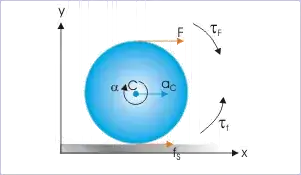Suppose a ball rolls on the ground. Obviously it is friction that helps to develop the required torque. Hence I find the direction of friction by pointing out the direction of rolling of the ball. But is there any intuitive method for predicting the direction of friction?
2 Answers
IF NO EXTERNAL FORCE ACTING ON BALL:
Friction will act opposite to net velocity at bottom-most point.
$v_{net_P}=v_{com}-Rw$
IF EXTERNAL FORCE IS ACTING ON BALL:
Suppose $x$ is distance above COM where force $F$ is applied.
$a_{net_P}=\dfrac Fm - \dfrac{FRx}{I}=\dfrac FM(1-\dfrac{Rx}{K^2})$.
If $a_{net_P}>0$ i.e. if $K^2>Rx$ point P will have a forward motion tendency.So friction acts backwards.
If $a_{net_P}<0$ i.e. if $K^2<Rx$ point P will have a backward motion tendency.So friction acts forward.
DID YOU KNOW ?
If the pulling force $F$ is removed from a body rolling on a rough surface,the friction force also disappears.The linear and angular speeds of the body is conserved and body keeps rolling!
Let us take an example to make the things more clear.
A force of magnitude F is acting on a rolling body of mass m and radius R.Discuss the different possibilities when the pulling force acts on the body.
a.At centre (at distance $r$) b.Above centre c.Below centre (at distance $r$)
Solution:
Let us assume the Force $F$ acts forward and friction $f$ acts backwards.
$(1)$ $F-f=ma_{c}$
$(2)$ $Fr+fR=(I_c+MR^2)\alpha$
$(3)$ $a=R\alpha$
On solving we get:
$a_c=\dfrac{F(1+\dfrac rR)}{M(1+\dfrac {I_c}{MR^2})}$ $\quad$ and $ \quad$ $f=\dfrac{F(I_c-MrR)}{I_c+MR^2}$
$a)$ Putting $r=0$ we get $a_c>0$ and $f>0$
$b)$ Putting $r>0$ we get two cases for friction force:
Acts backward if $r<\frac{I_c}{MR}$
Acts backward if $r>\frac{I_c}{MR}$
$c)$ Friction always acts backwards in this case.
I hope this will give you a good idea about friction and its direction in rolling motion. Now go ahead and solve more challenging problems !
Well intuitively you can do as follows :
I suppose a body (disc) which is both rolling as well as sliding.
Due to the velocity of centre of mass you can say that every pardiicle on that body has the same velociry lets say v. In particular the point touching fhe ground on which the disc rolls because that is of our interest.
Now lets say the disc was rotating with angular velocity w and had radius r, if we see from the centre of mass frame we can see the bottom most point will be having tangetial velocity due to rotation equal to w × r (and this velocity pointed in opposite direction of v).
Now if v is greater than (w×r) friction would be in opposite direction of v as that particular point woule be having tendency to move in direction of v.
In case v and ( w x r ) pointed in same direction the friction would be opposite to their direction.
So in summary, you can compare translational velocity with tangential velocity received due to rotation and find the direction intuitively
- 5,589
- 5
- 34
- 59

